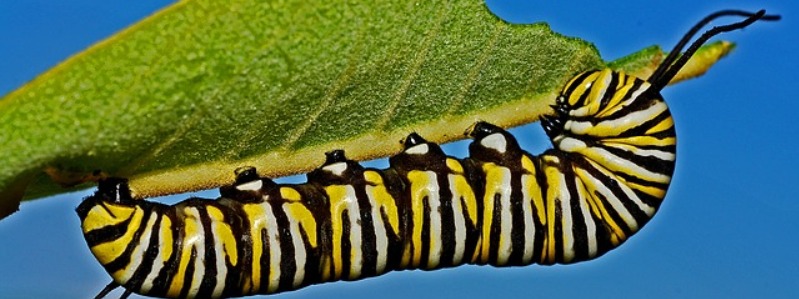List Of Texas Poisonous Caterpillars
Most caterpillars are in the larvae stage of usually flying or winged animals. As we have discussed here on this site on several occasions, Texas, owing to its agreeable climate and a juicy geographical location, is home to many plant and animal life. Some of those animals would not survive into adulthood unless they had some means of defending themselves from would-be predators- that is why they have come to have the ability to sting or introduce poison or toxins into the bodies of their attackers.
In this article, we want to look at the types of poisonous caterpillars in Texas that can sting and discuss all the interesting facts about them.
Venomous Caterpillars
Yes, venomous caterpillars do exist! They are found in various parts of the world, including North and South America, Africa, and Southeast Asia. These caterpillars have specialized organs that produce toxins that can cause multiple reactions when they come into contact with humans. The reaction’s severity depends on the venomous caterpillar type and the amount of communication.
The most well-known venomous caterpillar is the puss moth caterpillar, native to parts of Europe and North America. This species produces a toxin that causes severe skin irritation, pain, itching, blistering, and swelling. If ingested, other species may cause more severe reactions, such as nausea or vomiting.
It is essential to be aware of these creatures if you plan to spend time outdoors. If you come into contact with a venomous caterpillar, it is crucial to seek medical attention as their toxins can be dangerous if left untreated.
Dangers of Deadly Hair Spines
Venomous caterpillars, seemingly harmless creatures, can cause serious harm to humans. The hair spines of some species of caterpillars are particularly dangerous and potentially deadly. Many people assume that because caterpillars are tiny, they are not capable of causing any actual harm; however, this is far from the truth.
The tiny hairs on certain caterpillars contain venom, which can cause extreme discomfort and other adverse health effects if a person comes into contact with them. Symptoms such as burning sensations, itching, rashes, and even more severe reactions like anaphylactic shock can occur after contact with the spines of these venomous creatures. In some cases, the consequences can be fatal if left untreated or if a person is allergic to the venom produced by these animals.
How to Avoid the Venomous Caterpillar
Avoiding the venomous caterpillar is an important safety measure for those who work outdoors or spend time in nature. With more than 160,000 species of moths and butterflies worldwide, recognizing the signs of a potentially dangerous caterpillar is a good idea. By learning how to identify these creatures, you can take steps to avoid them and protect yourself from their venomous hairs or spines.
The most common venomous caterpillar has long tufts of bright-colored hair or spines. These caterpillars can be identified by their dark bodies with yellow stripes running down their sides. If you see one of these creatures, do not attempt to touch it, as they can cause a painful rash if their hairs come into contact with your skin. Instead, back away slowly and look for alternative routes around them if possible.
Treatments for Stings from Venomous Caterpillars
Venomous caterpillars are most commonly found on trees and shrubs in North America, but they can also be found in other parts of the world. Depending on the species, their sting can range from mild discomfort to severe pain and inflammation. Thankfully, there are a few treatments for dealing with these pesky caterpillars.
First and foremost, if you get stung by one of these creatures, it is advised that you immediately wash the area with soap and water to prevent any further irritation or infection. After cleaning the wound site, an antihistamine cream or ointment may be applied to reduce itching and inflammation caused by the sting. If more severe symptoms, such as swelling or significant pain, occur, it is essential to seek medical attention immediately.
Saddleback Caterpillar
The Saddleback Caterpillar (Acharia Stimulea) gets its name from its unique appearance. These caterpillars are usually green in the middle but have brown colors on the front and back of their bodies. These colors are typically bordered on white. When these caterpillars are fully grown, they have a general length of about 2cm. These caterpillars have two rows of stinging hairs on their bodies and are located on the sides of the creature’s bodies.
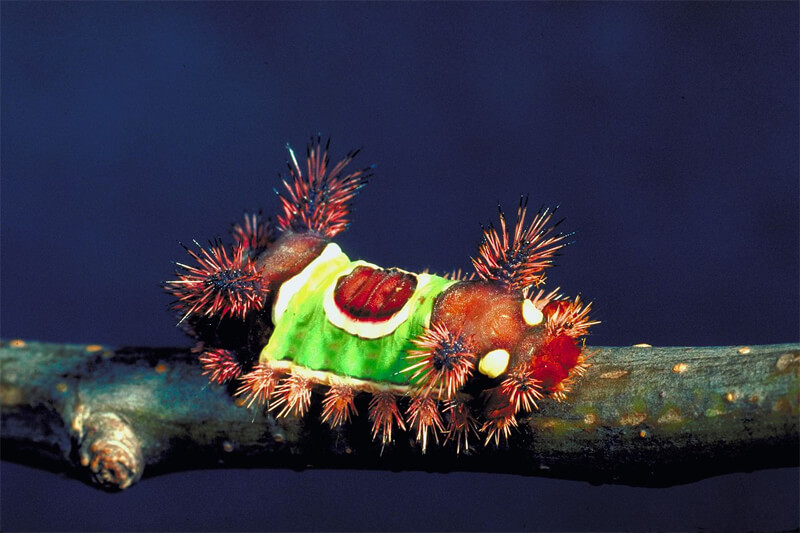
There is also some hair on their bodies’ front, and back ends. These hairs are sometimes called spines and function as a defense mechanism for the saddleback caterpillars. When an animal or a person touches a saddleback caterpillar, the spines break off and can deeply enter the skin, introducing toxins to the bodies of the treats. For humans, this encounter can result in intense burning sensations, swelling, and red blanching. In other people, the spines can cause rashes, reddish itching patches, and even tissue damage. Some people may need medical attention, as there may be allergic reactions.
These caterpillars feed on plants like maples, hibiscus, palms, and crape myrtle. So it is not unusual to find them in gardens or front yards, and they are doubtful to enter into homes.
Puss Caterpillar/Southern Flannel Moth
The Puss Caterpillar (Megalopyge Opercularis) is marked by soft hairs all over its body. This is probably the hairiest type of caterpillar you will likely encounter if you live in Texas. But those are not ordinary hairs- its security and defense systems have stiff spines underneath that have poison glands. If you mistakenly or intentionally touch them, the poisonous glands will break off into your skin and cause prolonged and severe pain.
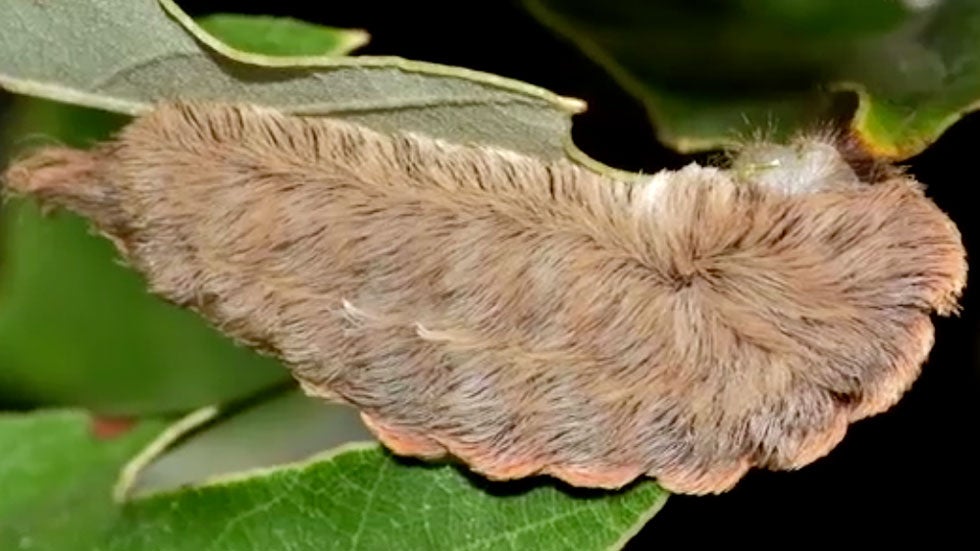
You can recognize them because they are covered with hair and are generally 2.5 cm long. They typically have a gray or brownish color, and the hairs are so dense that it covers the animal’s mouthparts.
These caterpillars usually feed on an extensive range of green leaves, including citrus, elms, and even oak trees.
Io Moth Caterpillar
The Io Moth Caterpillar (Automeris io) is a giant caterpillar that can grow to 6.5 cm in length. They generally have a light green color, while white and red strips run down the size of their bodies. These caterpillars have yellow or green protrusions coming out of their bodies, and these protrusions have black tips on them. Stay away from them! These protrusions are the caterpillars’ weapons. They are hollow and have stinging spines that can break off and enter deeply into the skin.
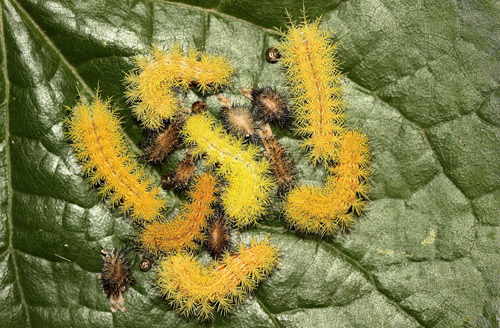
Sometimes a person may not even see these caterpillars but may make contact with them, and then he may suddenly notice that the affected area begins to itch, with severe burning sensations. The affected area may also turn red. Usually, the pain should reduce after about 2 hours, while the swelling should go down after about 8 hours.
You can recognize them because they are not hairy, are green in color, and have protrusions on their bodies. They can grow to be 6.5 cm in length.
These caterpillars feed on many plants, including hibiscus, elms, maples, wisteria, roses, azaleas, and willows.
Hag Caterpillars
the Hag Caterpillar (Photbetron pithecium) is a type of caterpillar marked by its brown color. This type of caterpillar has stinging hairs in pairs of lateral curved spines with various lengths. The spines have poison glands underneath them, and they release the poison into the skin by breaking off once they pierce the skin. When a person touches the hag caterpillar and has the toxins introduced into his body, symptoms vary in severity. They can range from burning or hot sensations to itching, redness, and inflammation. Sometimes this tiny creature can even trigger allergic reactions.
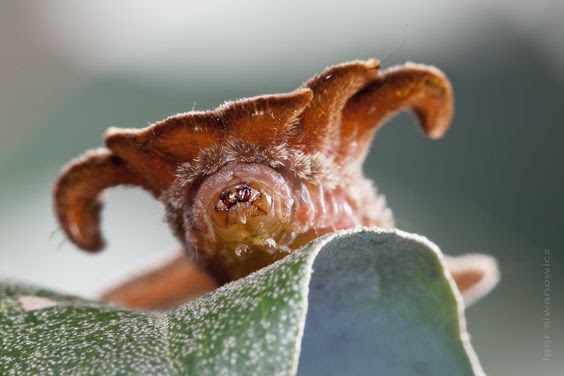
Their brown color can recognize them. And also by the two lateral rows of stinging hairs on its body.
Hag Caterpillars feed on many plants and prefer hard, woody ones like oak, apple, and dogwood.
Buck Moth Caterpillar
Buck Moth Caterpillars (Hermileuca maia) are a type of caterpillar that can be recognized by lateral rows of multi-branched spines along their backs. However, this type of caterpillar has two varieties- a light-colored type and a dark-colored type. The lateral rows of spines described above are the caterpillars’ self-defense apparatus. The toxin glands are the bases of the spines, and the spines break off into the skin of persons that touch them. The toxins of this caterpillar can produce reactions like redness, burning sensation, and swelling in the affected area. A symptom of this caterpillar’s stings can last up to a week. The dark type of caterpillar is the most common form.
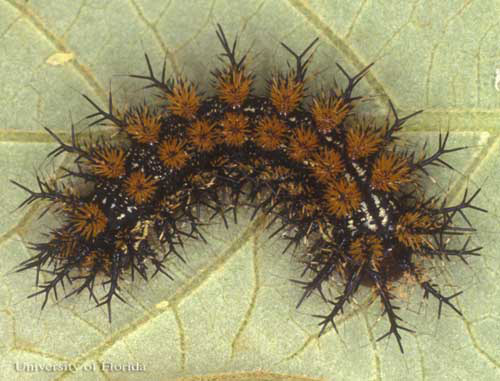
You can recognize them by lateral lines of spines running along their backs. They can be light or dark in color.
Spiny Oak Slug Caterpillar
Spiny Oak -Slug Caterpillars (Euclea Delphinii) are a type of caterpillar with a round shape overall. They have a range of colors that they can come in, so color is not the primary determinant of this species. Instead of hairs, they have spiny protrusions coming out of their bodies.
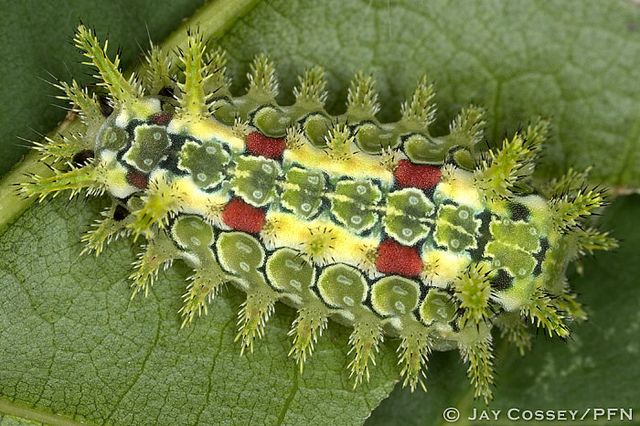
They grow to be about 2 cm long. They sting through these protrusions, which can cause redness, swelling, and itching. The stings of this caterpillar are generally less potent than those of the other caterpillars we have discussed so far.
Final Word
Caterpillars are generally gentle creatures that can sting to prevent getting eaten. Their stings usually get you to leave them alone, and they cannot kill. Balms and ointments are generally enough to deal with stings from caterpillars.

